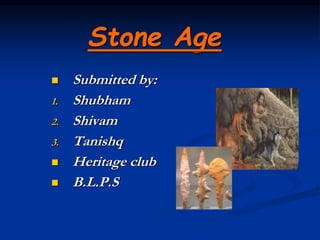
Stone age
- 1. Stone Age Submitted by: 1. Shubham 2. Shivam 3. Tanishq Heritage club B.L.P.S
- 2. The Stone Age is a broad prehistoric period during which humans widely used stone for toolmaking. Stone tools were made from a variety of different sorts of stone. For example, flint and chert were shaped (or chipped) for use as cutting tools and weapons, while basalt and sandstone were used for ground stone tools, such as quern-stones. Wood, bone, shell, antler (deer) and other materials were widely used, as well. During the most recent part of the period, sediments (like clay) were used to make pottery. A series of metal technology innovations characterize the later Chalcolithic (Copper Age), Bronze Age and Iron Age.
- 3. The period from 2 Million years ago (Mya)encompasses the first use of stone tools in Gona, Ethiopia and its spread and widespread use elsewhere soon thereafter.It ends with the development of agriculture, the domestication of certain animals, and the smelting of copper ore to produce metal. It is termed prehistoric since humanity had not yet started writing—the traditional start of history (i.e., recorded history).
- 4. It is the first age in the three-age system. A division of the Stone Age into older and younger parts was first proposed by Jens Jacob Worsaae in 1859 through his work with Danish kitchen middens that began in 1851.The subdivision into the Palaeolithic, Mesolithic and Neolithic periods that still is in use today, was made by John Lubbock in his now classic 1865 book Pre-historic Times. These three periods are further subdivided. In reality, the succession of phases varies enormously from one region (and culture) to another, indeed, humanity continued to expand into new areas even during the metal ages. Therefore, it is better to speak of a Stone Age, instead of the Stone Age. As a description of people living today, the term stone age is controversial. The Association of Social Anthropologists discourages this use.
- 5. Paleolithic Age During the Paleolithic age, humans were grouped together in small scale societies such as bands and gained their subsistence from gathering plants and hunting wild animals The Paleolithic is characterized by the use of knapped stone tools, although at the time, humans also used wood and bone tools. Other organic commodities were adapted for use as tools, including leather and vegetable fibers; however, given their nature, these have not been preserved to any great degree. Humankind gradually evolved from early members of the genus Homo such as Homo habilis, who used simple stone tools into fully behaviorally and anatomically modern humans (Homo sapiens sapiens) during the Paleolithic era. DNA and fossil evidence indicates that modern humans originated in east Africa about 200,000 years ago. During the end of the Paleolithic specifically the Middle and or Upper Paleolithic humans began to produce the earliest works of art and engage in religious and spiritual behavior such as burial and ritual.[ The climate during the Paleolithic consisted of a set of glacial temperatures.
- 6. Mesolithic Age The period starting from the end of the last ice age, 10,000 years ago, to around 6,000 years ago was characterised by rising sea levels and a need to adapt to a changing environment and find new food sources. The development of microlith tools began in response to these changes. They were derived from the previous Palaeolithic tools, hence the term Epipalaeolithic. However, in Europe the term Mesolithic (Middle Stone Age) is used, as the tools (and way of life) were imported from the Near East. There, microlith tools permitted more efficient hunting, while more complex settlements, such as Lepenski Vir developed based on fishing. Domestication of the dog as a hunting companion probably dates to this period. The earliest known battle occurred during the Mesolithic period at a site in Egypt known as Cemetery
- 7. Neolithic Age Due to the increased need to harvest and process plants, ground stone and polished stone artifacts became much more widespread, including tools for grinding, cutting, and chopping. The first large- scale constructions were built, including settlement towers and walls, e.g., Jericho and ceremonial sites, e.g.: Stonehenge. These show that there was sufficient resources and co-operation to enable large groups to work on these projects. To what extent this was a basis for the development of elites and social hierarchies is a matter of on-going debate.[17] Although some late Neolithic societies formed complex stratified chiefdoms similar to Polynesian societies such as the Ancient Hawaiians, most Neolithic societies were relatively simple and egalitarian[18] though Neolithic cultures were noticeably more hierarchical than the Paleolithic cultures that preceded them and Hunter-gatherer cultures in general.[19] The earliest evidence for established trade exists in the Neolithic with newly settled people importing exotic goods over distances of many hundreds of miles. The Ġgantija temples of Gozo in the Maltese archipelago are the oldest surviving free standing structures in the world, erected c. 3600-2500 BCE. Skara Brae located on Orkney island off Scotland is one of Europe's best examples of a Neolithic village. The community contains stone beds, shelves and even an indoor toilet linked to a stream.
- 8. This age lasted from 4000bc to 2000bc This was when man used both stone and copper tools This age is also called stone-copper age because discovery of copper held in this age
